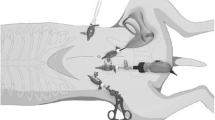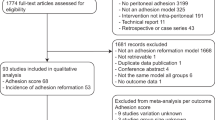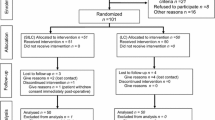Abstract
Background
The aim of this study was to evaluate the extent of postoperative adhesion formation after laparoscopic and open cholecystectomy.
Materials and methods
Qualified surgeons performed 60 experimental laparoscopic cholecystectomies (LC) in dogs with the aim to acquire the laparoscopic technique. To assess the relation between the complications during the operation (bleeding, laceration of the liver bed, or gallbladder perforation) and the formation of adhesions, surviving animals were divided into four groups according to the type of complication occurred. Assessment of the results was made by second-look laparoscopy 4 weeks after LC using the adhesion index (AI; score range, 0–4). The animals then were killed so the extent of adhesion formation could be measured. As a control, open cholecystectomy was performed in 15 dogs without intraoperative complications. The Mann-Whitney rank-sum test and Dunn’s method were used for statistical analysis.
Results
No adhesion formation or intraoperative complications were registered in the laparoscopic group I. In all the cases wherein bleeding or laceration of the liver bed occurred and was managed with electrocoagulation, adhesions formed. Adhesion formation in these groups was significantly higher than in “ideal LC” or cases of gallbladder perforation alone (p<0.01). All the animals in the control group developed significantly more adhesions than those in the experimental group (p<0.05).
Conclusions
It seems that LC has a lower rate of adhesion formation than the conventional open technique. Complications such as bleeding or laceration of the liver bed during LC can enhance adhesion formation. No adhesion formation can be mentioned in relation to gallbladder perforation during LC.
Similar content being viewed by others
References
Aziz R (1993) Microsurgery alone or with Interceed Absorbable Barrier for pelvic sidewall adhesion re-formation: the INTERCEED Adhesion Barrier Study Group II. Surg Gynecol Obstet 177: 135–139
Buckman RF, Sargent L, Gervin AS (1976) A unifying pathologic mechanism in the etiology of intraperitoneal adhesions. J Surg Res 20: 1–5
Bulleti C, Polli V, Giacomucci E, Flamigni C (1996) Adhesion formation after laparoscopic myomectomy. J Am Assoc Gynecol Laparosc 3: 533–536
De Iaco PA, Stefanetti M, Pressato D, Piana S, Dona M, Pavesio A, Bovicelli L (1998) A novel hyaluronan-based gel in laparoscopic adhesion formation. Fertil Steril 69: 318–323
Ellis H (1982) The causes and prevention of intestinal adhesions. Br J Surg 69:241–243
Ellis H (1997) The clinical significance of adhesions: focus on intestinal obstruction. Eur J Surg Suppl 577: 5–9
Garrard CL, Clements RH, Nanney L, Davidson JM, Richards WO (1999) Adhesion formation is reduced after laparoscopic surgery. Surg Endosc 13: 10–13
Halverson AL, Barrett WL, Bhanot P, Phillips JE, Iglesias AR, Jacobs LK, Sackier JM (1999) Intraabdominal adhesion formation after preperitoneal dissection in murine model. Surg Endosc 13: 14–16
Hansen K, Lowman L, Fiedler EP, Tho SP, Martindale R, McDonough PG (1999) Pelvic adhesion formation after intraperitoneal instillation of gallstones in a rabbit model. Fertil Steril 72: 868–872
Holmdahl L, Risberg B, Beck DE, Burns JW, Chegini N, diZerega GS, Ellis H (1977) Adhesions: pathogenesis and prevention-panel discussion and summary. Eur J Surg Suppl 577: 56–62
Luijendijk RW, de Lange DC, Wauters CC, Hop WC, Duron JJ, Pailler JL, Camprod Holmdahl L, van Deldorp HJ, Jeekel J (1996) Foreign material in postoperative adhesions. Ann Surg 223: 242–248
O’Leary DP, Coakley JB (1992) The influence of suturing and sepsis on the development of postoperative peritoneal adhesions. Ann R Coll Surg Engl 74: 134–137
Reissman P, Teoh TA, Skinner K, Burns JW, Wexner SD (1996) Adhesion formation after laparoscopic anterior resection in a porcine model: a pilot study. Surg Laparosc Endosc 6: 136–139
Risberg B (1997) Adhesions: preventive strategies. Eur J Surg Suppl 577: 32–39
Schafer M, Krahenbuhl L, Büchler MW (1998) Comparison of adhesion formation in open and laparoscopic surgery. Dig Surg 15: 148–152
Scott-Coombes DM, Vipond MN, Thompson JN (1993) General surgeon’s attitudes to the treatment and prevention of abdominal adhesions. Ann R Coll Surg Engl 75: 123–128
Thompson J (1998) Pathogenesis and prevention of adhesion formation. Dig Surg 15: 153–157
Tulandi T (1997) How can we avoid adhesions after laparoscopic surgery? Curr Opin Obstet Gynecol 9: 239–243
Zorluoglu A, Ozguc H, Yilmazlar T, Guney N (1997) Is it necessary to retrieve gallstones during laparoscopic cholecystectomy? Surg Endosc 11: 64–68
Author information
Authors and Affiliations
Additional information
Online publication: 7 May 2001
Rights and permissions
About this article
Cite this article
Gamal, E.M., Metzger, P., Szabó, G.Y. et al. The influence of intraoperative complications on adhesion formation during laparoscopic and conventional cholecystectomy in an animal model. Surg Endosc 15, 873–877 (2001). https://doi.org/10.1007/s004640000358
Received:
Accepted:
Issue Date:
DOI: https://doi.org/10.1007/s004640000358




